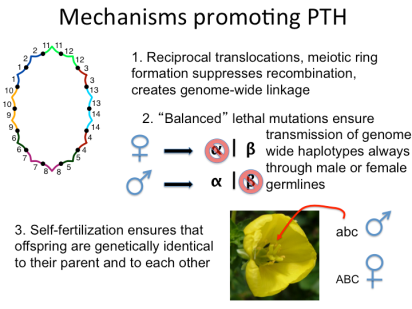We are developing the spectacular plant genus Oenothera (evening primrose) into a model system to answer fundamental questions about the evolutionary significance of chromosome recombination and segregation, as well as the roles of chromosome translocations and hybridization, respectively, in speciation. The ancestral state of this genus is sexual reproduction (outcrossing), however, ~30% of species have evolved a form of functional asexuality called Permanent Translocation Heterozygosity (PTH; see figure). My postdoctoral work, with Stephen Wright and Marc Johnson at the University of Toronto, examined the consequences of repeated evolution of functional asexuality in the plant genus Oenothera . We analyzed an RNAseq dataset from 30 Oenothera species that encompasses 10 transitions between sexual reproduction and PTH (functional asexuality). Ongoing work in the Hollister lab combines population genomics, transcriptome analysis, cytogenetics, and population modeling to address the following questions:
. We analyzed an RNAseq dataset from 30 Oenothera species that encompasses 10 transitions between sexual reproduction and PTH (functional asexuality). Ongoing work in the Hollister lab combines population genomics, transcriptome analysis, cytogenetics, and population modeling to address the following questions:
1. Does asexual reproduction reduce the efficacy of purifying selection on deleterious mutations? The answer is yes: (Ref 14) We are currently expanding this result by producing chromosome scale genome assemblies from two species (O. elata and O. grandiflora) whose ancestors hybridized to give rise to the widespread PTH species O. biennis. We have also sequenced the genome of O. biennis in order to infer patterns of molecular evolution in this PTH genome. These genome assemblies were generated using a variety of next generation sequencing datasets, including Illumina, Nanopore, PACBIO, HI-C, and Bionano. (Manuscripts in progress.)
2. How do the timescales over which PTH has evolved compare with speciation times among sexual/PTH pairs? Was speciation concurrent with the evolution of PTH? Did PTH evolve by inter-specific hybridization, or within-species accumulation of chromosome rearrangements? (Ref 16)
3. How do reciprocal translocations evolve within Oenothera populations? What are the population and molecular genetic factors underlying the high rate of translocations in this genus? How do the genes controlling crossing over and chromosome segregation differ among Oenothera species, and among genera in the Onagraceae? To address these questions, we are employing a combination of mathematical modeling, computer simulations, and molecular evolutionary analysis. (Manuscripts in progress.)
